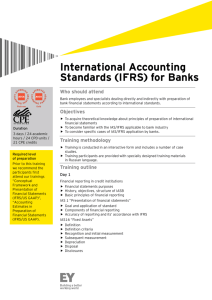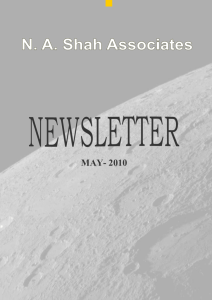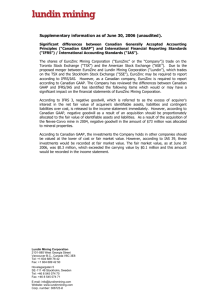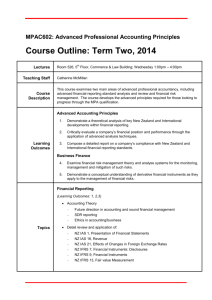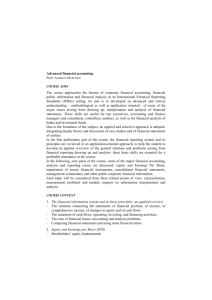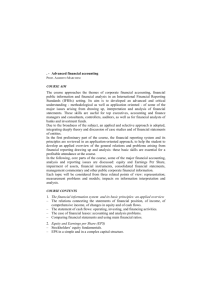IFRS 3 BUSINESS COMBINATIONS.
advertisement
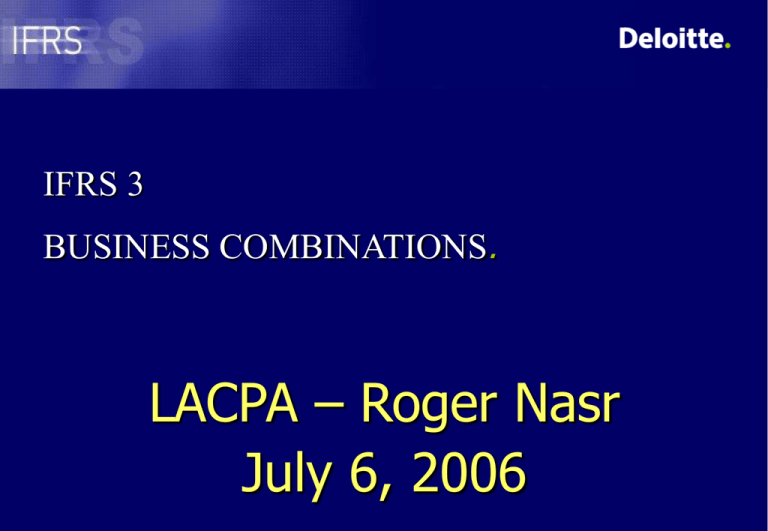
IFRS 3 BUSINESS COMBINATIONS. LACPA – Roger Nasr July 6, 2006 AGENDA Introduction Scope Application of the purchase method – including impairment of goodwill (IAS 36) & acquired intangible assets (IAS 38) Changes from IAS 22 Questions INTRODUCTION IFRS 3, Business Combinations Revised versions • IAS 36, Impairment of Assets • IAS 38, Intangible Assets Supersedes IAS 22, Business Combinations (1998) SIC 9, 22 and 28 withdrawn Main Changes in IFRS 3 Method? Must be accounted for using the purchase method Assets and liabilities acquired? More intangible assets & contingent liabilities recognised and measured at fair values Goodwill? Not amortised and tested for impairment annually Negative goodwill? Recognised in profit or loss immediately Restructuring costs? Only recognised to the extent acquiree’s liability exists at acquisition date SCOPE Business combination = A business combination is the bringing together of separate entities or businesses into one reporting entity IFRS 3 applies to all business combinations except – combinations of entities under common control – combinations by contract without exchange of ownership interest – formations of joint ventures APPLICATION OF THE PURCHASE METHOD All business combinations are accounted for by the purchase method Applying the purchase method • An acquirer is identified • The cost of the business combination is measured • The cost is allocated, at acquisition, to the assets, liabilities and contingent liabilities Identifying an acquirer An acquirer must be identified The acquirer is the entity that obtains control of the other entities IFRS 3 contains significant guidance on identifying the acquirer (e.g. relative fair values) The acquirer for accounting purposes may not always be the legal acquirer (reverse acquisitions) Cost of a business combination An acquirer measures the cost as the total of – fair values at date of exchange of assets given, liabilities incurred and equity instruments issued, plus – any directly attributable costs Equity instruments – If market price exists - use price at date of exchange – If market price doesn’t exist/unreliable - use other valuation technique Cost adjustments Accounting for adjustments to the cost of a business combination which are contingent on future events – include in the cost of combination if probable and can be measured reliably at acquisition date – treat as an adjustment to cost if subsequently meets condition – otherwise exclude Allocating the cost • Allocate cost by recognising, at fair values, identifiable assets, liabilities and contingent liabilities of acquiree • Goodwill = • Cost of acquisition - Total of net assets IAS 38 Intangible assets (recognition) • Recognised separately from goodwill if: • meet the definition of an asset - controlled by the entity - provide economic benefits • either separable or arise from contractual/legal rights • fair value can be measured reliably IAS 38 Intangible Assets (measurement) Cost model – Cost less accumulated amortisation and/or impairment losses OR Revaluation model – Fair value at date of revaluation less accumulated amortisation and/or impairment losses – Only allowed if an active market exists IAS 38 Intangible Assets (measurement) Subsequent expenditure – Only capitalise if will generate future economic benefits in excess of originally assessed standard of performance IAS 38 Intangible assets (classification) Intangible assets Indefinite useful lives Definite useful lives No amortisation Impairment test (annually and whenever indication of impairment) Amortisation (systematically over useful life) Impairment test (if indication) Contingent liabilities • Initial recognition - Recognised separately if fair value can be measured reliably • Subsequent recognition – Remeasure at the higher of • IAS 37 value • Initial amount less amortisation Goodwill Recognised as an asset – cost of acquisition - total of net assets Annual impairment test in accordance with IAS 36 – amortisation not allowed No negative goodwill – total of net assets > cost of acquisition – reassess fair values and cost of acquisition – recognise immediately as a gain IAS 36 Impairment of Goodwill Allocate goodwill to cash generating units (CGU) before impairment test – the smallest group of assets generating independent cash inflows – represents the lowest level at which goodwill is monitored internally – not larger than a segment (IAS 14) Impairment test annually per CGU – not necessarily at year end IAS 36 - Impairment model (reminder) New carrying amount (after write-down) Lowest of Carrying amount before the impairment test Recoverable amount Highest of Fair value less costs to sell Value in use IAS 36 – Allocation of impairment loss The impairment loss is allocated in the following order – 1st reduce the carrying amount of any goodwill allocated to the CGU (or group of units) – 2nd reduce the carrying amounts of the other assets (pro rata based on carrying amounts) A write-down due to an impairment is recognised in profit or loss Reversal of write-down of goodwill is prohibited IFRS 3 BUSINESS COMBINATIONS. (Case Studies) IFRS 3 Business Combinations Scope Facts – Strawberry Ltd acquired the shares in Lemon Ltd on 1 July 2004, based on a valuation performed by corporate financiers, for Euro 15 million. – The sole asset of Lemon was the patent right for genetically engineered fruit technologies. – Strawberry recognised Euro 15 million as goodwill. IFRS 3 Business Combinations Scope (cont) Question – Is this treatment correct? Strawberry 100% Lemon (Patent) IFRS 3 Business Combinations Scope (cont) Definition of business – Integrated set of activities and assets conducted and managed for the purposes of providing: A return to investors or Lower costs or other economic benefits – Consists of: Inputs Process applied to inputs Outputs used to generate revenues IFRS 3 Business Combinations Scope (cont) Guidance – Inputs PPE, Intangibles, Intellectual property, Ability to obtain access to necessary materials, Employees – Processes Systems, standards, protocols that define processes – Outputs Ability to obtain access to customers that purchase output IFRS 3 Business Combinations Acquisition date Facts – A company acquires a business. – The acquisition needs approval from a Competitions Authority (antitrust legislation) before acquisition can be implemented. Question – Is this approval necessary prior to the recognition of the acquisition as a business combination? IFRS 3 Business Combinations Identification of acquirer Facts – Nedcor makes partial offer for Stanbic on the basis of 1 Nedcor share for every 5.5 Stanbic shares – Value of bid Nedcor ZAR 27 750 million Stanbic ZAR 29 238 million – Market capitalisation Nedcor ZAR 27 039 million Stanbic ZAR 29 624 million IFRS 3 Business Combinations Identification of acquirer (cont) Facts (cont) – aStatement of intent “Nedcor intends, in conjunction with Stanbic management to realise benefits of merger. Nedcor intends to retain key staff and clients in both banks to ensure that both parties participate in new entity.” Question – Who is the acquirer? IFRS 3 Business Combinations Identification of acquirer (cont) Theory – “the combining entity that obtains control of other combining entities” – Indicators Fair value Entity giving up cash or assets Management IFRS 3. (IFRS 2 Link) IFRS 3 Cost of acquisitionIFRS 2 link Facts – Company A purchases 100% of Company B’s shares from management for a combination of cash and shares. – In addition, Company A will pay additional consideration to the previous owners/management if revenues exceed 100 million over the next year. – Each individual must be employed with the new company for the duration of the contingency period to receive the additional consideration. IFRS 3 Cost of acquisition - IFRS 2 link (cont) Question – Would such transactions be within the scope of IFRS 2 or IFRS 3? IFRS 3 Business Combinations Questions?


